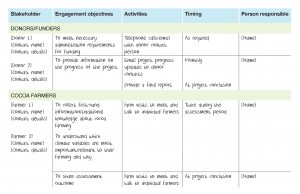Step 1: Identify Stakeholders and Plan Engagement
Stakeholder engagement is an essential and overarching activity for developing climate change information. Stakeholders should be engaged, consulted and participate actively in all steps of the process as appropriate. This is to ensure that the outputs are reliable and made relevant and accessible to all stakeholders.
Key activities
- Identify stakeholders
- Define how and why each stakeholder will be engaged
- Prepare a stakeholder engagement plan
- Implement the stakeholder engagement plan
Identify stakeholders
A stakeholder is anyone whose views need to be considered, who can contribute to the development of climate change information, and who needs to know or will use the developed information. In this context, stakeholders are also often referred to as providers, next or end-users of information.
Stakeholders can be individuals, groups or institutions. They may come from different backgrounds (e.g. science, government, communities or donor agencies), either from public or private enterprises, and typically represent a broad cross-section of interests from regional to national/sub-national and local community level.
A simple way to identify the stakeholders is to initially determine two key stakeholders, such as a representative from an NMHS (who provides the information) and a sectoral user of the information. These two key stakeholders can then facilitate broader engagement and thereby identify other stakeholders who are, in turn, asked the same question until no other individuals/institutions can be identified.
If possible, the roles and responsibilities of key stakeholders need to be defined. These roles and responsibilities may be organised according to their contribution to the proposed risk assessment (e.g. providing data for analysis, disseminating and/or applying results) or according to their influence or mandate in the relevant decision-making process (e.g. planners, policy makers, legislators, politicians).
Define why and how each stakeholder will be engaged
Defining stakeholder engagement objectives – that is, what participants hope to get out of the assessment and the relationship with other stakeholders – is important for determining the appropriate stakeholder engagement approach.
For example, the development of the information may be funded by a development partner such as an international donor who may wish to be directly involved in the assessment or otherwise requires regular progress updates. The objective is to keep such stakeholders adequately informed in a timely manner to meet their particular needs.
The primary stakeholder for sectoral risk assessments would typically be a national or provincial government sector, which has responsibility for developing strategies to enable effective and efficient adaptation to climate change or climate-related natural disasters. However, local community groups, such as farmers, fishers and church, school and women’s groups, are also important stakeholders. Not only will they be affected by decisions that are made by sectoral policy-makers and planners based on the assessment, but they can also offer important local information about the risks being assessed. In this instance, there are two engagement objectives: to collect first-hand information including any traditional knowledge about the climate hazards and impacts being considered, and to share the outcomes of the assessment to raise awareness and ground-truth the results with those communities mostly directly affected by climate change.
Each of the identified stakeholders or group of stakeholders may require a specific engagement strategy and activities. For example, to keep donors informed of the progress of the work, periodic briefing emails can be sent with a short update, with a final detailed report prepared at the end of the work. In the case of local community stakeholders, regular on-site meetings (with a group or individually) may be an effective way to collect and share information.
Prepare a stakeholder engagement plan
The stakeholder engagement plan should outline engagement objectives for each key stakeholder (or group of stakeholders) and the activities and timeline for meeting each of the objectives. This plan will be a valuable tool for ensuring that all key stakeholders are appropriately engaged in most steps.
A stakeholder engagement plan does not have to be complex – a simple table that sets out the stakeholder details, engagement objective, activities, timing and person responsible is all that is needed to manage effective and efficient engagement. The following example is for a Pacific Islands cocoa farming sector risk assessment. Key stakeholder groups to consider for the first column include donors/funders, sectors (e.g. agriculture, water), NMHSs and community stakeholders (such as the cocoa farmers).

Implement the stakeholder engagement plan
Following this plan will ensure that the relevant stakeholders are involved in each step of developing climate change information, as appropriate. It is a good idea to print a copy of the plan and keep it in plain sight (e.g. on a pin board or wall) as a reminder of upcoming activities. The plan can also be revised along the way to accommodate new learnings through the subsequent steps.
